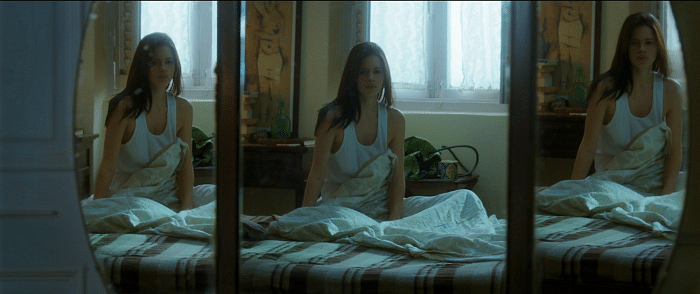
Siddharth Sinha’s new short, The Job, is a complex and intelligent thriller that delivers, albeit in a slightly unconventional way.
The film tells the story of an unnamed woman (Kalki Koechlin; difficult to imagine anyone else doing such justice) who isn’t doing great at keeping her jobs. Sinha’s characters, — even in his previous film, the brilliant Udedh Bun — have not much use for their names, and even lesser use for dialogues.
The woman has moved through four jobs in six months, and at her latest, where she works as a translator from French to English, she has been given a deadline to finish an assignment.
But there’s something keeping her from getting her job done: flashes of memory from which she has to jerk back to the present. There’s something else: try as she might, there’s something she can’t scrape off from her hands.
The Job is Sinha’s adaptation of Macbeth. Focusing on the life of a French expatriate who seems to be lugging life along in an Indian metropolis, not all elements of Shakespeare’s play survive into Sinha’s film; in fact only one does: an obsessive Lady Macbeth.
The stain, visible only to her, seems to be coming back always. "All the liquids soaps of Arabia will not sweeten this little hand," she may have said if Sinha allowed her dialogues.
The Job may be a detective film without a detective. And as in many detective films without a detective, the burden often falls on the viewer. If this is true of The Job, Sinha’s unsuspecting viewer is in for a surprise.
Here’s the difficulty: how does a detective “detect” anything when he or she can’t distinguish between what’s fantasy and what’s reality?
In a scene where her boss speaks to her, for the most part, the camera is focused just on the face of the woman, but when Sinha finally decides to bring the boss into the frame, we see only an empty chair, even as the man’s voice continues to speak as a voiceover.
Similarly, when our Lady Macbeth bends down to feed her cat milk, we see that there is no cat at all. Just a ghostly meow without a source.
We may be tempted to draw a Fight Club-like explanation for this — to claim that it is all in the woman’s head. But Sinha does not let us go that easily. If there is no boss, how is the job at stake and why is her mother hounding her about losing another job? Was she, weird as it is, sitting in his office after he left and recounting an earlier scene? If there is no cat, what (or who) emptied the bowl?
To make matters worse, the alternate realities are not water-tight compartments. One seems to stray into another casually. For instance, a recurring image-sound in the film is that of a car moving through a tunnel. But we hear the sound while Kalki’s character sits in her office as well. But suddenly her train of thoughts is broken and from then we hear only the regular office sounds.
Another instance: the first time we hear the character’s mother talk to her — in French — we notice her overbearing tone and realise that the mother is a huge part of the woman’s life. Such a voiceover is common in films, usually denoting a memory the character is remembering at a given time.
But here it’s a little more. The voiceover continues as Kalki gets ready to go to office and picks up her bag. The “memory” suddenly tells her, “Don’t take this bag, take the leather one. It goes better with your dress”.
A semblance of an explanation to these conflicting realities is seen when we find the woman waking up in her room to catch a glimpse of herself in the mirror. We see three adjacently placed mirrors. As she stares into them, the camera glides slowly to the left bringing into focus her reflections in all three mirrors.
Given how carefully shot the scene is, it almost calls to be read as a symbol. A symbol of what? That we are to not demand one story from the film, but rather let the permutations and combinations reveal several?
The Job is a difficult film if we seek coherent explanations. If we are willing to look beyond this, we see a play of realities, lending them to a series of trials and errors.
The viewer may or may not come to a satisfactory explanation of the events, but that is fine, as the pleasures of Sinha’s film lie in more elusive corners. It lies in the juxtaposition of the realities that demand evaluation and comparison. It also lies in Sinha’s masterful craft, which is both rewarding and challenging at the same time.